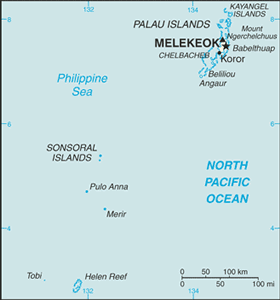The Geography of Palau
The Geography of Palau
Palauan Geography
Location: Oceania, group of islands in the North Pacific Ocean, southeast of the Philippines
Geographic coordinates: 7 30 N, 134 30 E
Map references: Oceania
Area: total: 458 sq km land: 458 sq km water: 0 sq km
Area - comparative: slightly more than 2.5 times the size of Washington, DC
Land boundaries: 0 km
Coastline: 1,519 km
Maritime claims: territorial sea: 3 nm exclusive fishing zone: 200 nm
Climate: tropical; hot and humid; wet season May to November
Terrain: varying geologically from the high, mountainous main island of Babelthuap to low, coral islands usually fringed by large barrier reefs
Elevation extremes: lowest point: Pacific Ocean 0 m highest point: Mount Ngerchelchuus 242 m
Natural resources: forests, minerals (especially gold), marine products, deep-seabed minerals
Land use: arable land: 8.7% permanent crops: 4.35% other: 86.95% (2005)
Irrigated land: NA
Natural hazards: typhoons (June to December)
Environment - current issues: inadequate facilities for disposal of solid waste; threats to the marine ecosystem from sand and coral dredging, illegal fishing practices, and overfishing
Environment - international agreements: party to: Biodiversity, Climate Change, Climate Change-Kyoto Protocol, Desertification, Law of the Sea, Ozone Layer Protection, Wetlands, Whaling signed, but not ratified: none of the selected agreements
Geography - note: westernmost archipelago in the Caroline chain, consists of six island groups totaling more than 300 islands; includes World War II battleground of Beliliou (Peleliu) and world-famous rock islands


